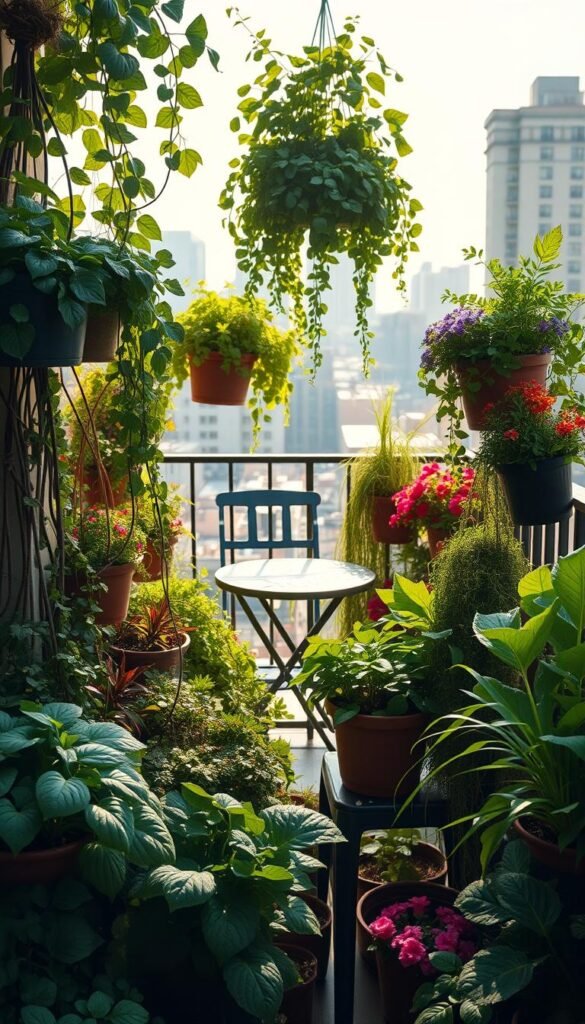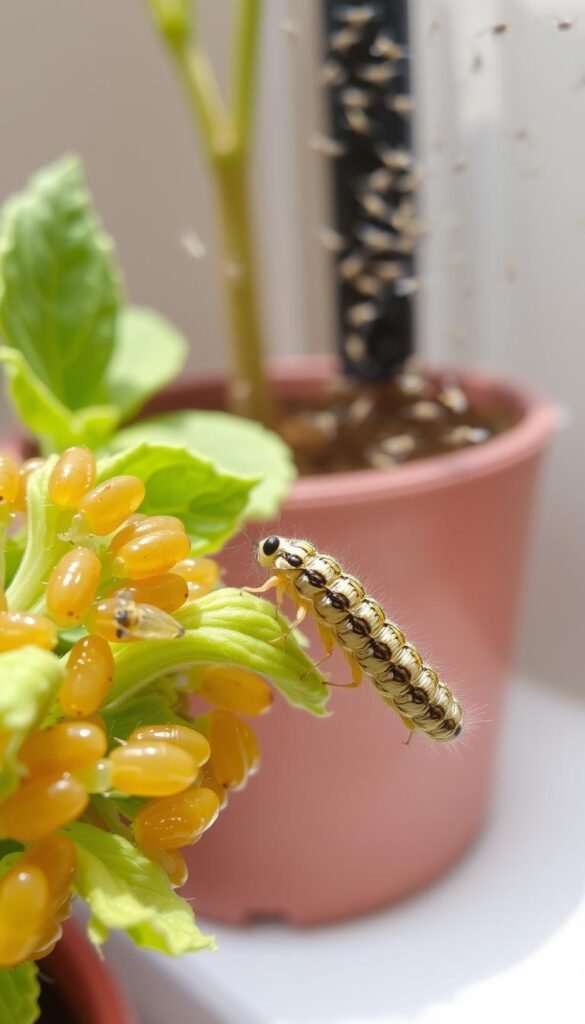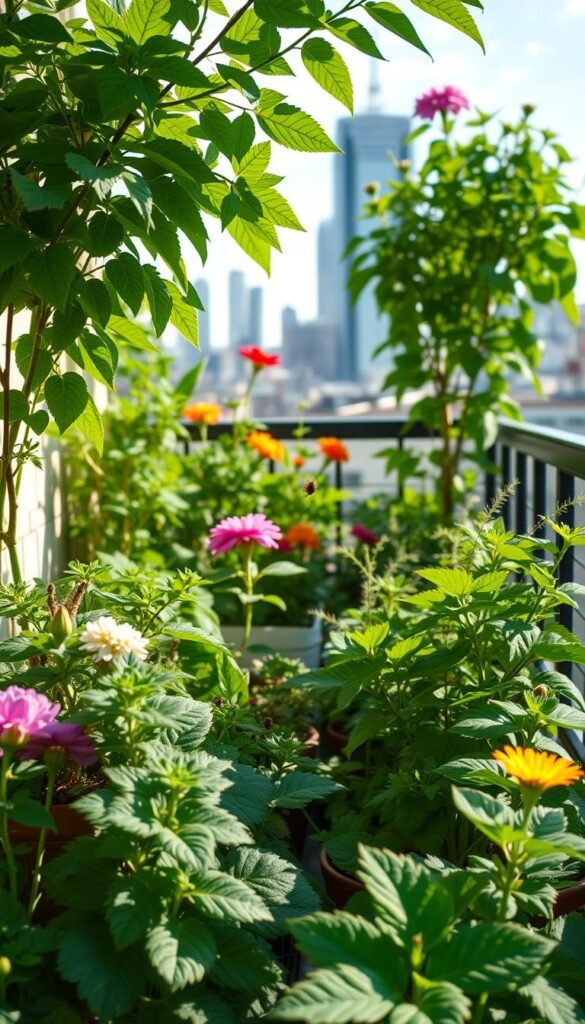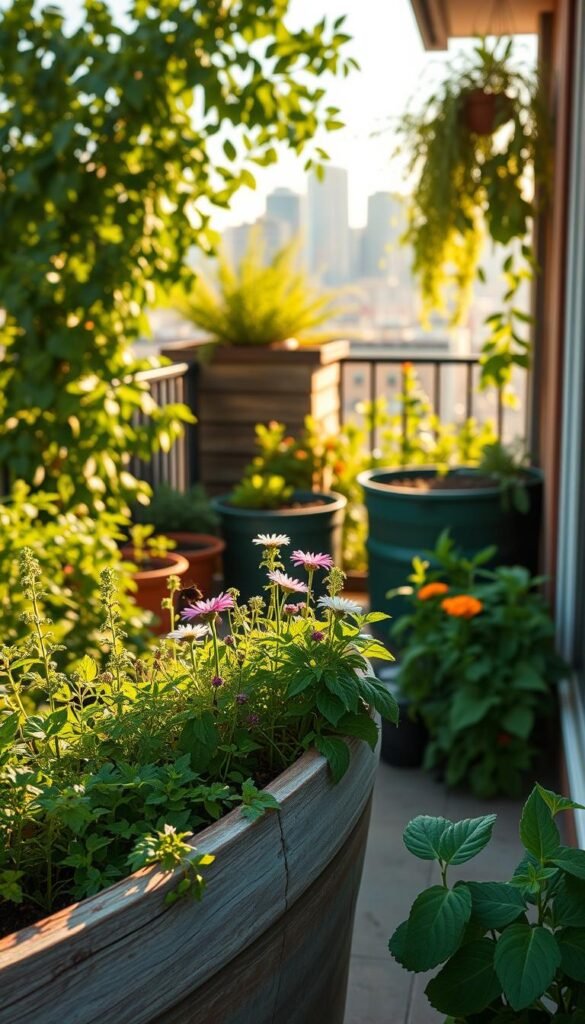Your balcony garden is a sanctuary of greenery, but unwanted visitors can disrupt its harmony. Instead of harsh chemicals, organic gardening methods offer a safer way to protect your plants. These approaches not only deter harmful infestations but also nurture a healthier environment for pollinators and beneficial insects.
Balancing your mini-ecosystem is key. Introducing natural predators like ladybugs or lacewings helps manage aphids and mites without toxins. Companion planting—like pairing basil with tomatoes—creates a natural defense system. You’ll reduce reliance on sprays while encouraging biodiversity.
Simple homemade remedies, such as neem oil or garlic spray, tackle common issues without harming soil quality. These solutions are cost-effective and align with sustainable practices. Plus, they keep your herbs, flowers, and veggies safe for you and local wildlife.
Healthy soil is the foundation of a resilient garden. Regularly enriching it with compost improves plant immunity against invaders. By prioritizing non-disruptive strategies, you’ll create a space where nature’s balance does most of the work for you.
Starting Your Eco-Friendly Balcony Garden

Building a vibrant green space above ground level begins with intentional choices. Organic growing methods work with nature rather than against it, creating habitats where plants and helpful species thrive together. This approach reduces chemical exposure while fostering long-term resilience.
Why Organic Methods Matter
Chemical-free gardening keeps your herbs and veggies safe for snacking. Studies show organic soils host 30% more earthworms, improving nutrient circulation naturally. You’ll also support bees and butterflies—critical pollinators often harmed by synthetic sprays.
Smart Plant Selection
Compact varieties like dwarf tomatoes or bush beans excel in containers. Pair them with aromatic herbs such as rosemary to deter unwanted nibblers. Here’s a quick guide to space-friendly options:
| Plant Type | Sun Needs | Pest-Resistant Traits |
|---|---|---|
| Basil | Full sun | Repels flies/mosquitoes |
| Marigolds | 6+ hours | Deters beetles/nematodes |
| Nasturtiums | Partial shade | Traps aphids |
Water deeply but less frequently to encourage strong roots. Check leaves weekly for spots or holes—early detection stops most issues. Wipe dusty foliage to help plants breathe better and resist invaders.
Understanding Common Garden Pests on Your Balcony

Your elevated green space brings joy, but some tiny visitors might overstay their welcome. Recognizing the difference between harmful bugs and helpful allies keeps your plants thriving. Let’s explore how to spot trouble before it escalates.
Identifying Insect Pests and Recognizing Damage
Watch for these clues on leaves and stems:
- Chewed edges or holes: Often caused by caterpillars or beetles
- Sticky residue: A sign of aphids feeding on plant sap
- Yellow speckles: Spider mites leave this telltale pattern
Check soil weekly—fungus gnats thrive in damp dirt. Gently lift pots to inspect roots for white grubs. Early morning inspections work best when bugs are most active.
Spotting Beneficial Insects in Your Garden
Not all six-legged visitors are foes. Ladybug larvae devour aphids, while lacewings snack on mealybugs. Look for:
- Metallic-green sweat bees pollinating flowers
- Parasitic wasps (harmless to humans) targeting tomato hornworms
“Aphid populations dropped 40% faster when gardeners allowed predator insects to establish.”
Healthy gardening practices—like rotating plants and avoiding overcrowding—make your space less inviting to destructive bugs. Remember: diversity in your plant selection supports natural pest management.
Eco-Friendly Pest Control Solutions for Balcony Gardens

Transform your urban oasis into a self-regulating ecosystem with nature’s own defense systems. By working alongside beneficial insects and strategic plant pairings, you’ll tackle issues before they escalate.
Recruit Nature’s Cleanup Crew
Ladybugs and lacewings act as living pest control, devouring aphids and mites. Purchase larvae online or create inviting habitats:
- Place shallow water dishes with pebbles for drinking
- Leave some leaf litter for shelter
- Plant yarrow or dill to attract predatory species
Mix Up Your Plant Partners
Companion planting creates invisible shields around vulnerable greens. Try these dynamic duos:
| Protector Plant | Protected Crop | Pests Deterred |
|---|---|---|
| Chives | Peppers | Aphids, spider mites |
| Mint | Cabbage | Cabbage moths |
| Sunflowers | Cucumbers | Ants, beetles |
Whip Up Kitchen Counter Solutions
Three easy recipes to combat common garden pests:
- Garlic blast: Blend 10 cloves with 2 cups water. Strain, add 1 tsp dish soap
- Soap shield: Mix 1 tbsp mild soap + 1 cup vegetable oil. Dilute 2 tbsp per quart
- Seaweed spray: Steep dried seaweed overnight. Strain and mist leaves
Apply treatments at dusk when beneficial insects are less active. Rotate formulas to prevent pest resistance. This guide helps maintain balance—your greens stay healthy without collateral damage.
Prevention Techniques for a Pest-Free Balcony

A thriving container garden starts with smart groundwork. By focusing on foundational practices, you’ll create conditions that naturally discourage insect pests while promoting plant health.
Building Healthy Soil and Utilizing Sterile Potting Mixes
Begin with clean containers—scrub old pots with vinegar to eliminate hidden eggs. Sterile potting mixes prevent introducing larvae or fungi from outdoor soil. Research shows store-bought mixes reduce common garden infestations by 65% compared to reused dirt.
| Soil Type | Pest Risk | Nutrient Quality |
|---|---|---|
| Backyard Soil | High (grubs, mites) | Variable |
| Sterile Mix | Low | Controlled release |
| Compost Blend | Moderate | Rich in microbes |
Implementing Proper Watering and Foliage Care
Overwatering attracts fungus gnats—let soil dry slightly between sessions. Water at the base to keep leaves dry, reducing mold risks. Follow this three-step check for new plants:
- Examine leaf undersides for insect damage or eggs
- Quarantine newcomers for 3 days
- Trim yellowing foliage before planting
Pair these strategies with organic gardening principles. Introduce natural predators like nematodes to handle soil-dwelling larvae. A balanced ecosystem means fewer pests garden battles and more time enjoying your green retreat.
Organic Treatment Methods for Infestations

When tiny invaders threaten your leafy retreat, immediate action keeps damage minimal. Manual strategies let you address problems precisely while protecting your garden’s delicate balance. Start with simple tools and observation—often the most effective first line of defense.
Hand-Picking Pests and Mechanical Removal Strategies
Slip on gardening gloves and grab a jar of soapy water. Many insects—like cabbage worms or beetles—can be plucked directly from leaves. Check plants daily, especially under leaves where eggs hide. For smaller pests, use tweezers or a soft brush to dislodge them.
Gentle treatments preserve helpful predators like ladybugs. Avoid broad-spectrum sprays that harm these allies. Focus on problem areas using targeted methods that leave your mini-ecosystem intact.
| Treatment Type | Effectiveness | Safety | Frequency |
|---|---|---|---|
| Neem Oil Spray | High (soft-bodied insects) | Non-toxic | Weekly |
| Diatomaceous Earth | Moderate (crawling pests) | Safe when dry | After rain |
| Synthetic Pesticides | Rapid | Risks pollinators | As needed |
Follow these steps for safe removal:
- Inspect plants early morning when pests are active
- Remove visible insects by hand
- Apply organic sprays only to affected areas
Use a magnifying glass to spot tiny eggs on stems. Wipe leaves with diluted vinegar to discourage mites. These methods work best when combined with regular monitoring—your vigilance becomes the ultimate treatment.
Utilizing Traps, Barriers, and Non-Toxic Sprays
Guarding your leafy haven requires clever defenses that work while you relax. Proactive tools like sticky traps and physical barriers intercept invaders before they settle in. Pair these with companion strategies for a multi-layered shield that respects your garden’s balance.
Deploying Sticky Traps and Pheromone Lures
Bright yellow sticky traps act as silent sentries, snagging whiteflies and fungus gnats mid-flight. Pheromone lures mimic insect mating signals, drawing pests away from your herbs. Follow these steps for best results:
- Position traps 6–12 inches above food crops
- Replace every 2–3 weeks or when covered
- Use blue traps for thrips, yellow for aphids
Timing matters—set traps before pests peak. Early spring placement catches first-generation flies, reducing summer populations.
Creating Effective Physical Barriers
Row covers and mesh screens block beetles while letting sunlight through. Try these materials:
| Barrier Type | Material | Pests Blocked |
|---|---|---|
| Floating Row Cover | Polyester fabric | Moths, leafminers |
| Copper Tape | Self-adhesive strip | Slugs, snails |
| Fine Mesh Netting | Nylon/polyethylene | Aphids, cabbage worms |
Boost your defenses by planting garlic near roses—its scent confuses aphids. A soap-based spray (1 tbsp dish soap + 1 quart water) adds extra protection when applied at dusk. These companion tactics work best when started early, giving plants time to thrive undisturbed.
Encouraging Natural Predators for Sustainable Control
Inviting helpful allies to your urban garden creates a self-sustaining defense system. Beneficial insects act as nature’s pest managers, reducing beetle populations and other leaf-munchers without chemicals. By designing an environment that welcomes these tiny guardians, you’ll keep your plants thriving through natural checks and balances.
Attracting Ladybugs, Lacewings, and Hover-Flies
These predators target aphids, mites, and beetle larvae. Place shallow dishes with water and pebbles to hydrate them. Grow nectar-rich flowers like alyssum or cosmos—their blooms provide energy for adult insects hunting pests.
Three ways to make your area irresistible:
- Leave some leaf litter in pots for shelter during hot days
- Avoid broad-spectrum sprays that harm both pests and allies
- Install insect hotels with bamboo tubes for nesting
“Gardens with predator-friendly habitats saw 50% fewer aphid outbreaks within two growing seasons.”
Sustain populations by rotating flowering plants throughout the year. Dill and fennel attract lacewings in summer, while yarrow keeps ladybugs active into fall. Products like pre-made insect habitats or pheromone-free lures can supplement natural efforts in high-rise environments.
| Plant | Predator Attracted | Target Pest |
|---|---|---|
| Dill | Lacewings | Aphids |
| Sunflowers | Hover-flies | Thrips |
| Calendula | Ladybugs | Mealybugs |
Urban gardeners in Chicago reported 75% fewer beetles after adding marigolds and water stations. Your balcony can become a launchpad for these miniature protectors—just give them the right environment to thrive.
Final Tips for Maintaining a Thriving, Pest-Free Balcony Garden
Nurturing a thriving green retreat above the city streets requires consistent care. Start with weekly plant inspections—flip leaves to spot early signs of trouble. Keep a journal to track changes in growth or bug activity. This habit helps you act fast before minor issues become full-blown infestations.
Stick to preventive measures like companion planting and homemade sprays. Introduce predator-friendly plants like marigolds to sustain nature’s cleanup crew. If problems arise, try soap-based solutions first. Reserve chemical insecticides for severe cases only.
Create a simple maintenance checklist:
- Water at soil level to avoid damp foliage
- Refresh mulch every 4-6 weeks
- Rotate container positions seasonally
Healthy plants naturally resist invaders. Feed them compost tea monthly and prune overcrowded stems. Remember: thriving ecosystems rarely need harsh interventions. Your attentive care—paired with non-toxic sprays—keeps both greenery and beneficial insects flourishing.
With these strategies, you’ll master the art of balanced gardening. Each small action builds a resilient oasis where life thrives above the urban bustle.






